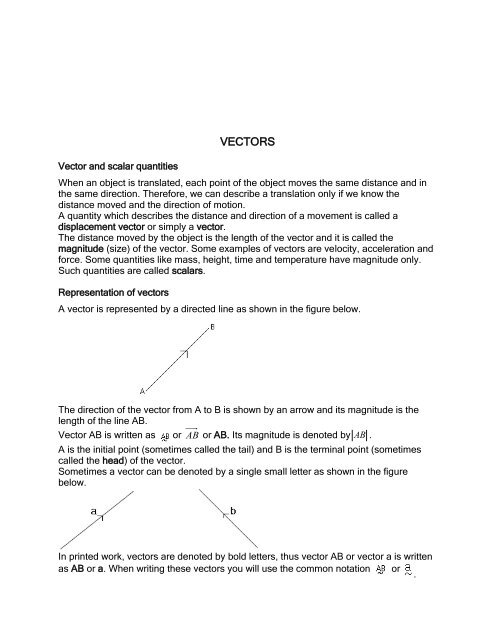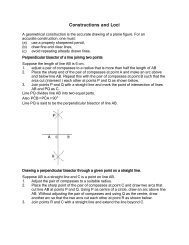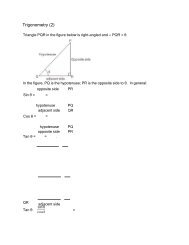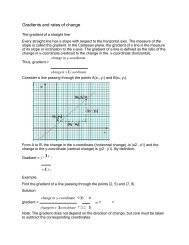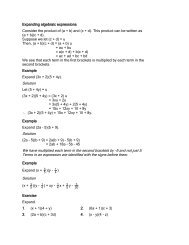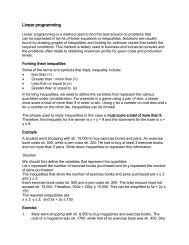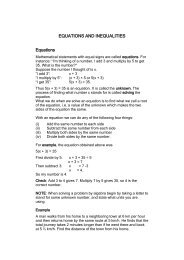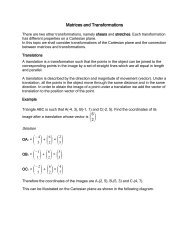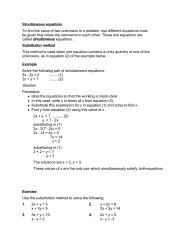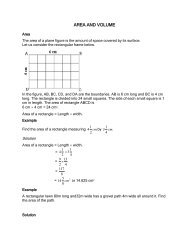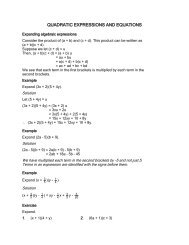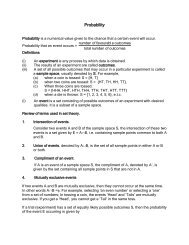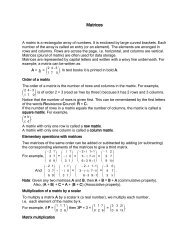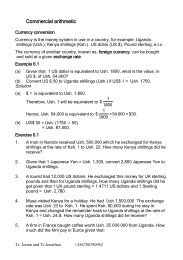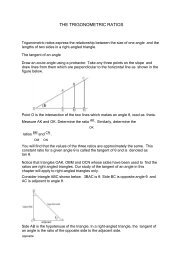J13
You also want an ePaper? Increase the reach of your titles
YUMPU automatically turns print PDFs into web optimized ePapers that Google loves.
Vector and scalar quantities<br />
VECTORS<br />
When an object is translated, each point of the object moves the same distance and in<br />
the same direction. Therefore, we can describe a translation only if we know the<br />
distance moved and the direction of motion.<br />
A quantity which describes the distance and direction of a movement is called a<br />
displacement vector or simply a vector.<br />
The distance moved by the object is the length of the vector and it is called the<br />
magnitude (size) of the vector. Some examples of vectors are velocity, acceleration and<br />
force. Some quantities like mass, height, time and temperature have magnitude only.<br />
Such quantities are called scalars.<br />
Representation of vectors<br />
A vector is represented by a directed line as shown in the figure below.<br />
The direction of the vector from A to B is shown by an arrow and its magnitude is the<br />
length of the line AB.<br />
Vector AB is written as or AB or AB. Its magnitude is denoted by AB .<br />
A is the initial point (sometimes called the tail) and B is the terminal point (sometimes<br />
called the head) of the vector.<br />
Sometimes a vector can be denoted by a single small letter as shown in the figure<br />
below.<br />
In printed work, vectors are denoted by bold letters, thus vector AB or vector a is written<br />
as AB or a. When writing these vectors you will use the common notation or<br />
.
Translations<br />
If the object moves in such a way that all its points move through the same distance and<br />
in the same direction, the object is said to have undergone a translation.<br />
Consider a translation from point A to B in the figure below.<br />
If each square is of one unit length, the translation is shown by the vector AB and can be<br />
described as a displacement of 6 units to the right and 4 units upwards. This is written<br />
6 <br />
as AB = .<br />
4<br />
When a displacement vector is written in this way it is called a column vector. The<br />
number at the top represents the horizontal displacement and the lower number<br />
represents the vertical displacement.<br />
The figure below shows a displacement from P to Q.<br />
The vector PQ is a displacement of 6 units to the left and 2 units downwards. This is<br />
<br />
6 <br />
written as PQ = .<br />
<br />
2<br />
It is important to note that whenever the displacement is towards the right or upwards, it<br />
is a positive displacement whilst displacement to the left or downwards is negative.<br />
Example
Triangle XYZ is such that X(-2, 1), Y(-3, 2) and Z(-3, 4). It is given a translation of vector<br />
7 <br />
. Find the coordinates of its image, X1 Y 1 Z 1<br />
2<br />
Solution:<br />
7 <br />
Points X, Y and Z undergo a translation of vector . The image, X1 Y 1 Z 1 , is such that<br />
2<br />
X 1 (5, 3), Y 1 (4, 4) and Z 1 (4, 6).<br />
Note: When an object undergoes a translation, all points move through the same<br />
distance and in the same direction. Thus, lines XX 1 , ZZ 1 and YY 1 are parallel and equal.<br />
Exercise<br />
1. Write the column vectors of the translations shown in the figure below.
2. On a squared paper draw the vectors represented by the following column vectors.<br />
(a)<br />
3<br />
1<br />
<br />
PQ = <br />
(b) IJ = <br />
4<br />
<br />
2<br />
(c)<br />
5<br />
2<br />
RS = <br />
(d) MN = <br />
2<br />
3 <br />
(e)<br />
0<br />
2<br />
AB = <br />
(f) CD = <br />
3<br />
0<br />
Equivalent vectors<br />
Vectors are equal if they have the same magnitude and the same direction. The figure<br />
below shows two pairs of equivalent vectors. UV = WX and u = v.<br />
3<br />
<br />
3 <br />
Note: If AB = then, BA = . The vectors AB and BA have the same length but<br />
4<br />
<br />
4<br />
opposite directions.<br />
Given a point P(x1, y1), we can plot the point on a graph paper by locating it x1 units and<br />
y1 units from the origin. When this point is joined to another point<br />
(x2, y2), the directed line joining the two points form a vector.<br />
Example
Plot the points P(2, 3) and Q(7, 4) and show vector PQ.<br />
Solution<br />
Exercise<br />
1. A translation maps the origin of the Cartesian plane onto (2, 4). Under the same<br />
translation, where would the following points be mapped?<br />
(a) (-2, 1) (b) (2, 4)<br />
(c) (-5, -2) (d) (0, 1)<br />
2. A triangle, ABC, is such that A is (1, 1), B(1, 4) and C(5, 1). Find the coordinates of<br />
the images of A, B and C when the triangle is translated by vectors:<br />
(a)<br />
<br />
1<br />
<br />
<br />
1<br />
(b) AB<br />
(c) CA (d) CB<br />
Position vectors<br />
These are column vectors which originate from the origin.
In the figure above, Q is a point whose coordinates are (7, 4). The position vector of R,<br />
7 <br />
denoted as OR or simply r, is given by OR = r = .<br />
4<br />
Also, the coordinates of point P are (2, 3). The position vector of point P, denoted as OP<br />
2 <br />
or p is given by OP = p = .<br />
3<br />
In general, if a point P has coordinates (x, y) then its position vector is<br />
x <br />
OP = p = .<br />
y<br />
Adding vectors<br />
An object at point A(-1, 1) is given a translation r =<br />
to point B as shown below.<br />
2<br />
3<br />
followed by a translation p = <br />
2<br />
1
5<br />
Note that a single translation q = is equivalent to these two translations. We also<br />
3<br />
note that vector q is the sum of r and p. Thus,<br />
2 3 2<br />
3<br />
5 <br />
r+ p = q or + = = .<br />
2<br />
1<br />
2<br />
1<br />
3<br />
Although the r + p is equivalent to q, the length of r plus the length of p is greater than<br />
the length of q. Therefore, the + sign simply shows that r + p is a displacement r<br />
followed by displacement p.<br />
When adding vectors, the horizontal displacements and the vertical displacements are<br />
added separately.<br />
x1<br />
Thus, if a = x<br />
2<br />
and b =<br />
y<br />
<br />
then,<br />
1 y<br />
2 <br />
x1<br />
a + b = x<br />
2<br />
+<br />
y x1<br />
x2<br />
=<br />
1 y<br />
<br />
.<br />
2 y1<br />
y<br />
2 <br />
Example<br />
3 1 2 <br />
Given that a = , b = , c = , find:<br />
4<br />
6<br />
3<br />
(a) a + b (b) a + c<br />
(c)<br />
a + b + c<br />
Solutions<br />
(a)<br />
3 1<br />
3<br />
1 4<br />
<br />
a + b = + = = .<br />
4<br />
6<br />
4<br />
6<br />
10<br />
<br />
(b)<br />
3 2 3<br />
2<br />
5 <br />
a + c = + = = .<br />
4<br />
3<br />
4<br />
3<br />
1<br />
<br />
(c)<br />
3 1<br />
2 3<br />
1 2 6 <br />
a + b + c = + + = = .<br />
4<br />
6<br />
3<br />
4<br />
6 3<br />
7<br />
If a point is given a translation a followed by a translation b, the resulting displacement is<br />
the translation c. See figure below. This is written as<br />
a + b = c. Where a + b means a followed by b.
Note that the tail of b is joined to the head of a so that the tail of the resultant vector, c, is<br />
joined to the tail of a, the initial position, and its head joined to the head of b, the final<br />
position.<br />
Consider translation b followed by translation a as in the figure below.<br />
The resulting displacement is still the same translation c. Thus b + a = c. It is important<br />
to note that the resulting translation can be obtained by starting with either a or b, as<br />
shown in the combined diagram in the figure below.<br />
Note that a + b = b + a.<br />
Subtracting vectors<br />
When subtracting, 6 and -4 may be written as 6 + (-4). Similarly, when we subtract<br />
vectors, we may write a – b = a + -b. The vector –b is the negative vector of b. Thus, if b =<br />
4<br />
<br />
4<br />
then –b = and can be represented diagrammatically as shown in the figure<br />
5<br />
<br />
5<br />
below.<br />
Note that both vectors have the same length and are parallel to each other, but are in<br />
the opposite directions.<br />
7<br />
3 <br />
Thus, given a = and b = ,<br />
5<br />
2
7<br />
3<br />
7 <br />
3<br />
a – b = - or a – b = + <br />
5<br />
2<br />
5<br />
<br />
2<br />
7<br />
3<br />
7<br />
3<br />
= <br />
= <br />
5<br />
2<br />
5<br />
2<br />
4<br />
4 <br />
= <br />
= .<br />
3<br />
3<br />
7 <br />
3 4 <br />
Therefore, a – b = a + -b = + = .<br />
5<br />
<br />
2<br />
3<br />
Consider points A(2, 3) and B(9, 5) in the figure below.<br />
The position vectors of A and B are given as<br />
2<br />
9<br />
OA = a = and OB = b = <br />
3<br />
5<br />
OA + AB = OB<br />
AB = OB – OA<br />
= b – a<br />
9<br />
2 7<br />
= - = <br />
5<br />
3<br />
2<br />
AO = -OA = -a. Thus, AB = AO + OB.<br />
Example<br />
2 <br />
Given that the coordinates of point P are (4, -3) and PQ = , find the coordinates of<br />
5<br />
point Q.<br />
Solution
4 <br />
The position vector of P is OP = .<br />
3<br />
The position vector of Q is given by:<br />
OQ = OP + PQ<br />
4 2 6 <br />
= + = .<br />
3<br />
5<br />
2<br />
The coordinates of Q are (6, 2).<br />
The zero vector<br />
Consider two vectors, c and d, such that translation c followed by translation d returns to<br />
the initial point.<br />
What can you say about the two translations? Do you notice that the vectors of the two<br />
translation are exactly the same length but in opposite directions?<br />
Such a result is called a zero or (null) vector. This is because there is effectively no<br />
change in the position. A zero vector is written as O.Thus,<br />
c + d = O. Therefore, c = -d. A vector RP has the same magnitude as the vector PR, but<br />
its direction is opposite to that of PR.<br />
PR + RP = O and RP = -PR<br />
Exercise<br />
1. State the position vectors of the following points:<br />
(a) P(5, 3) (b) Q(2, 3)<br />
(c) R(-6, 8) (d) S(-3, -4)<br />
(e) T(0, 2) (f) U(-3, 0)<br />
2. State the coordinates of the points with the following position vectors:<br />
(a)<br />
1<br />
<br />
<br />
4<br />
(b)<br />
0<br />
<br />
3
1<br />
(c) <br />
<br />
3<br />
(d)<br />
5<br />
<br />
0 <br />
3. In each of the following, draw p + q and state its column vector.<br />
4. Given that OR = OP + OQ, state the coordinates of R when the coordinates of P<br />
and Q are:<br />
(a) P(0, 1) and Q(3, 6)<br />
(b) P(-3, 2) and Q(5, 1)<br />
(c) P(-4, -3) and Q(2, 0)<br />
(d) P(1, -7) and Q(6, 2).<br />
5. Write down negatives of each of the following vectors:<br />
(a)<br />
7<br />
<br />
5<br />
<br />
(b) <br />
11<br />
6<br />
(c)<br />
<br />
3<br />
2<br />
<br />
(d) <br />
<br />
3<br />
0<br />
(e)<br />
4<br />
0<br />
<br />
(f) <br />
8<br />
0<br />
6. P is (5, 3), Q is (-4, 2) and R is (2, -3). Find the column vectors PQ, RQ and RP.<br />
7.<br />
0 <br />
The coordinates of point A are (2, 1) and AB = . Find the coordinates of B.<br />
5<br />
8. Given A(6, 3) and B(-4, 9), find the coordinates of C when:<br />
(a) OC = OA + OB
(b) OC + OB = OA<br />
0 3 <br />
9. Given that p = , q = and q + r = p, express r as a column vector.<br />
4<br />
5<br />
1 3<br />
<br />
5 <br />
10. If r = , s = and t = , determine:<br />
2<br />
4<br />
<br />
6<br />
(a) r + s (b) r + s – t (c) r – (s + t)<br />
Multiplying vectors by a scalar<br />
2<br />
In the figure below, r = and has been added to itself.<br />
1<br />
<br />
2 2 4 <br />
r + r = + = .<br />
1<br />
1<br />
2<br />
The addition of R to itself gives r + r = 2r. Thus,<br />
2 2<br />
2<br />
4 <br />
2r = 2<br />
= = . The number 2 is a scalar value in 2r. In general, when a<br />
1<br />
2<br />
1<br />
2<br />
a<br />
a<br />
ka <br />
vector is multiplied by a scalar k, we get k = . The scalar k can be any<br />
b<br />
<br />
b<br />
kb<br />
positive or negative number. Each component of the vector is multiplied by the scalar.<br />
Example<br />
2<br />
4 <br />
Given a = and b = , find the value of:<br />
3<br />
10<br />
(a) 4a (b)<br />
1<br />
b<br />
2<br />
(c) 3a - 21<br />
b (d) 3a + 2b<br />
Solution<br />
2 8<br />
(a) 4a = 4<br />
= <br />
3<br />
12
1 1 4 2<br />
(b) b = = <br />
2 2 10<br />
5<br />
2<br />
1 4 6 2<br />
(c) 3a - 21<br />
b = 3<br />
= + <br />
3<br />
2 10<br />
9<br />
5<br />
8 <br />
= .<br />
4<br />
2 4<br />
(d) 3a + 2b = 3 + 2 <br />
3<br />
10<br />
6 8 2 <br />
= + = <br />
9<br />
20 29 <br />
Note: When a vector is multiplied by a positive scalar, its direction does not change.<br />
However, when a vector is multiplied by a negative scalar, its direction is reversed.<br />
The magnitude of a vector<br />
The length of a vector is called magnitude. In the figure below the magnitude of OA is<br />
the length of line OA and is denoted as OA or a or a.<br />
Triangle OAB is right-angled at point B. We can use the Pythagoras’ theorem to find the<br />
length of line OA. Thus<br />
2<br />
OA OB BA<br />
= 6 2 + 3 2<br />
= 36 + 9<br />
= 45<br />
OA = 45<br />
Therefore, OA = a = 6.708 units.<br />
Note that the column vector of OA is<br />
2<br />
2<br />
6<br />
and OA is<br />
2 2<br />
6 3 .<br />
3
a<br />
In general, the magnitude of a column vector t = also denoted as |t|, is given by<br />
b<br />
<br />
2 2<br />
a b<br />
Since the magnitude of a vector is its length, the quantity is always a positive scalar.<br />
Example<br />
2<br />
5<br />
Given that, a = and b = determine:<br />
3<br />
4<br />
(a) |a| (b) |b|<br />
(c) |a + b| (d) |a - b|<br />
Solutions<br />
(a) |a| =<br />
2 2<br />
2 3 = 13 = 3.606<br />
(b) |b| =<br />
2 2<br />
( 4) = 25 16<br />
5 <br />
= 41<br />
= 4.403.<br />
2 5 7<br />
(c) a + b = + = <br />
3<br />
4<br />
1<br />
|a + b| =<br />
7 <br />
2 2<br />
( 1) = 50<br />
= 7.071.<br />
2<br />
5 3<br />
(d) a – b = - = <br />
3<br />
4<br />
7 <br />
|a – b| =<br />
Example<br />
2 2<br />
3) 7 = 9 49<br />
( <br />
= 58 = 7.616<br />
3 <br />
Given r = , find:<br />
4<br />
(a) |r| (b) |2r|<br />
(c) 2|r| (d) |kr|<br />
Solutions<br />
(a) |r| =<br />
2<br />
3 ( <br />
4)<br />
2<br />
= 9 16 = 25 = 5.
3 6<br />
(b) 2r = 2<br />
= <br />
4<br />
8 <br />
|2r| =<br />
2<br />
6 ( <br />
= 36 64<br />
8)<br />
= 100 = 10<br />
2 2<br />
(c) 2|r| = 2 3 ( 4)<br />
<br />
= 2 25 = 2 5 = 10<br />
3 3k<br />
<br />
(d) kr = k<br />
= <br />
4<br />
4k<br />
<br />
|kr| =<br />
=<br />
=<br />
2<br />
2<br />
( 3k)<br />
( 4k<br />
2 2<br />
9k 16k<br />
2<br />
25k = 5k<br />
)<br />
2<br />
From this example, multiplying a vector by a scalar, k, also multiplies its magnitude by k.<br />
In general, |kr| = k|r|.<br />
Exercise<br />
1. Evaluate the following:<br />
(a)<br />
3<br />
2<br />
<br />
1<br />
(c)<br />
<br />
4<br />
5 <br />
<br />
5<br />
(b)<br />
1 <br />
10<br />
2 <br />
1 <br />
5 <br />
(d)<br />
0<br />
3 <br />
1<br />
<br />
(e)<br />
<br />
1<br />
1<br />
-8 <br />
(f) -7 <br />
<br />
1<br />
0<br />
(g)<br />
1 3<br />
110<br />
<br />
<br />
(h) <br />
3 9<br />
5 5<br />
2. Given A(6, 3) and B(-4, 12), find the coordinates of C when:<br />
(a)<br />
1 1<br />
OC = OA + OB<br />
3 4<br />
(b)<br />
(c)<br />
OC = 2OA + OB,<br />
OC +<br />
2<br />
1 OB = 2OA
1 3<br />
1 <br />
3. If r = , s = and t = , determine:<br />
3<br />
4<br />
3<br />
(a) 4r – t (b) 2s – 3r<br />
(c)<br />
3r + s +<br />
3<br />
1 t<br />
4. Determine the magnitudes of the following vectors:<br />
(a)<br />
4<br />
1<br />
<br />
(b) <br />
2<br />
3<br />
(c)<br />
6<br />
<br />
4<br />
<br />
(d) <br />
8<br />
<br />
7<br />
5<br />
8 <br />
5. Given that a = and b = calculate:<br />
3<br />
6<br />
(a)<br />
1<br />
| 2<br />
b | (b) |a - b<br />
2 1 |<br />
(c) |a + b| (d) |-2a|<br />
a a<br />
1<br />
6. Given that r = and s = and |r| = |s|, find a.<br />
3<br />
2 <br />
1 3 <br />
7. If a = , b = and |a| = |b|, find the value of y.<br />
y 1<br />
y 2<br />
8. PQR is a straight line such that PQ 2QR.<br />
(a) Given P(6, 0) and R(4, 3), write down the column vectors for OP and OR.<br />
(b) If OP = p and OR = r, express RP, RQ and OQ in terms of p and r. Hence find<br />
the coordinates of point Q.<br />
Equality of vectors<br />
x1<br />
Two vectors x<br />
2<br />
and<br />
y<br />
<br />
are equal if x1 = x2 and y1 = y2.<br />
1 y<br />
2 <br />
Note: Two vectors are equal if they have the same magnitude and same direction<br />
Example<br />
6k <br />
Given a = , b =<br />
4 <br />
Solution<br />
<br />
<br />
<br />
6k 10<br />
<br />
= <br />
4 5 n<br />
10<br />
<br />
and a = b, determine the value of k and n.<br />
5 n<br />
10 5<br />
, then 6k = 10 or k = = and 4 = 5 + n. Therefore, n = -1<br />
6 3
k =<br />
3<br />
5 and n = -1.<br />
The null vector<br />
The vector<br />
dented as O orO<br />
Mid-points<br />
0<br />
has no magnitude and no direction. It is therefore, a null or zero vector<br />
0<br />
A point that bisects a vector is called its mid-point. To find the mid-point of a vector we<br />
get the point that lies halfway on the position vector.<br />
Suppose M is the mid-point of OA in the figure below, then<br />
8 <br />
4 1<br />
OA = and OM = . OM = OA.<br />
6<br />
3<br />
2<br />
This means that the position vector of point M is half the position vector of point A.<br />
If M is the mid-point of a line AB where A is the point (x1, y1) an B is the point (x2, y2) then<br />
the coordinates of M are given by<br />
x1 x2<br />
y1<br />
y2<br />
M = , .<br />
2<br />
Example<br />
2<br />
Find the mid-point, N, of points A(1, 5) and B(3, 7).<br />
Solution<br />
x1 = 1, y1 = 5; x2 = 3, y2 = 7<br />
1<br />
3 5 7 <br />
The coordinates of N are , <br />
2 2 <br />
4 12 <br />
Therefore, N<br />
, = N(2, 6).<br />
2 2
Exercise<br />
1. PQRS is a parallelogram with points P3, 1), Q(12, 5) and R(6, 8). Find:<br />
(a) PQ,<br />
(b) the coordinates of S<br />
(c) |QS|.<br />
2. Given A(1, 4), B(6, 7) and D(1, -2), and that ABCD is a trapezium such that DC =<br />
3AB, find the coordinates of C.<br />
3. Show that the points U(-4, -2), V(-1, -3), W(5, 0) and X(2, 1) are vertices of a<br />
parallelogram.<br />
4. Find the mid-point of AB given A(-8, 5) and B(1, 4).<br />
5.<br />
6 <br />
Given X(7, 14), XY = . Find:<br />
8<br />
(a) the coordinates of Y,<br />
(b) XN,<br />
(c) the coordinates of N<br />
6. The point M , 1<br />
1 is the mid-point of points A(a, -3) and B(4, b). Find a and b.<br />
2<br />
2<br />
7. Triangle ABC with vertices A(-1, 1), B(1, 3) and C(2, 1) is translated by vector <br />
1<br />
. Find the coordinates of the vertices of the image.<br />
3 4 <br />
8. Given that a = and b = , find:<br />
2<br />
6<br />
(a) a + 2b (b) 3a -<br />
2<br />
1 b<br />
(c) |a – 2b|<br />
9. Given r = a – 2b and s = 3a + b, express the following vectors in terms of a and b:<br />
(a) r – s (b) 4s + 3r<br />
2 <br />
10. Given point B(5,3) and AB = , find the coordinates of point A.<br />
4 <br />
4 <br />
11. Given point N(-6, 8) and NM = , find the mid-point of NM.<br />
4<br />
12. Show that quadrilateral ABCD with vertices A(1, 2), B(4, 4), C(4, 1) and D(1, -1) is<br />
a parallelogram. Determine the coordinates of the point of intersection of its<br />
diagonals.<br />
13. Point M(-3, 4) is the mid-point of points A and B. If the coordinates of A are<br />
(-5, 1), find the coordinates of B.
14. Given that quadrilateral PQRS with vertices P(2, 4), Q(8, 8), R(8, 2) and S(2, -2) is<br />
a parallelogram. Find:<br />
(a) the magnitudes of the diagonals,<br />
(b) the coordinates of the point of intersection of its diagonals.<br />
Revision of Vectors<br />
Vector Geometry<br />
A scalar is a quantity with magnitude (size) only.<br />
A vector is a quantity with both magnitude and direction.<br />
Velocity is speed in a given direction and is thus a vector.<br />
e.g 15 m/s is a speed.<br />
15 m/s on a bearing 070 0 is a velocity since the direction is given.<br />
A vector can be represented on paper by a line segment, say AB, showing magnitude<br />
4<br />
and direction or by an ordered set of numbers. We can write vector AB as AB = a = <br />
3<br />
<br />
When writing these vectors you will use the common notation or
4<br />
AB = is referred to as column or displacement vector.<br />
3<br />
<br />
A position vector starts from the origin. If P is the point (x,y) and O is the origin, then the<br />
x <br />
position vector of P is OP = <br />
y<br />
Also, if A and B have position vectors a and b with reference to the origin O, then AB = b<br />
– a.<br />
Vector addition and subtraction<br />
(i)<br />
(ii)<br />
Vectors are added by the Triangle Rule of vector addition, i.e. where vector a ends<br />
b starts.<br />
AB + BC = AC<br />
The triangular rule follows from the parallelogram law. If AB and AD are two nonparallel<br />
vectors drawn through A, then the sum AB + AD is called the resultant<br />
vector.<br />
The resultant is AC, the diagonal through A of the parallelogram whose sides are<br />
AB and AD.<br />
AB + AD = AB + BC = AC = a + b<br />
AD + DC = AC = b + a.<br />
Hence a + b = b + a<br />
Subtraction can also be performed in a similar way.<br />
CB = -BC. (The negative sign reverses the direction of the vector).<br />
AB – CB = AB – (-BC)<br />
= AB + BC<br />
= AC.<br />
Multiplication by a scalar
a<br />
a<br />
ka <br />
When a vector is multiplied by a scalar k, we get k = . The scalar k can be<br />
b<br />
<br />
b<br />
kb<br />
any positive or negative number. Each component of the vector is multiplied by the<br />
scalar.<br />
Parallel vectors<br />
If a = kb, where k is a scalar, then a is parallel to b. Conversely, if a is parallel to b, then<br />
a = kb.<br />
3 <br />
6 6 <br />
For example, is parallel to , because may be written<br />
5<br />
10<br />
10<br />
<br />
3 <br />
2 .<br />
5 <br />
a<br />
a <br />
In general the vector k<br />
is parallel to .<br />
b<br />
<br />
b<br />
<br />
Collinearity<br />
If AB = kBC, where k is a scalar, then AB is parallel to BC.<br />
But B is common, so A, B and C lie on a straight line, i.e. the points A, B and C are<br />
collinear.<br />
Proportional division of a line<br />
(a)<br />
(b)<br />
AP : PB = 3 : 1, then we say that P divides AB internally in the ratio 3 : 1. (P lies<br />
between A and B).<br />
Note: The direction is important as P divides BA in the ratio 1 : 3.<br />
AP = 4 3 AB and PB = 4 1 AB<br />
Example<br />
AQ : QB = 4 : -1.<br />
The negative sign is required as QB is in the opposite direction to AB. We say that<br />
Q divides AB externally in the ratio 4 : 1, or Q divides AB in the ratio 4 : -1.<br />
Whenever Q is outside AB (on either side), AQ : QB will be negative, and we say<br />
that Q divides AB externally.<br />
Write down the relationship between the vectors a, b and c.
Solution<br />
Using the vector law of addition, a + b = c<br />
Example<br />
In OCD, OC = c and OD = d.<br />
(a) Express CD in terms of vectors c and d.<br />
(b) M is the midpoint of CD. What is CM in terms of c and d?<br />
(c) Using your answers to (a) and (b), find OM in terms of c and d.<br />
Solution<br />
(a)<br />
(b)<br />
(c)<br />
CD = CO + OD = -OC + OD<br />
= -c + d or d – c<br />
Therefore, CD = d – c.<br />
CM = 21<br />
CD<br />
= 21<br />
(d – c).<br />
OM = OC + CM<br />
= c + 21<br />
(d – c) = c - 21<br />
c + 21<br />
d<br />
= 21<br />
c + 21<br />
d<br />
= 21<br />
(c + d)<br />
Example<br />
In the diagram below, P divides the line AB in the ratio AP : PB = 7 : 3. If OA = a and OB<br />
= b, express OP in terms of a and b.
Solution<br />
In triangle OAB, OA + AB = OB<br />
a + AB = b<br />
AB = b – a<br />
Along AB, AP = 7 AB<br />
10<br />
= 7 ( b <br />
10<br />
a)<br />
OP = OA + AP = a + 7 ( b a )<br />
Example<br />
10<br />
3 a<br />
7<br />
10 10<br />
= b<br />
In the figure below, OA = a and OB = b.<br />
(a) E xpress BA in terms of a and b.<br />
(b) If X is the mid-point of BA, show that OX = 1 2<br />
(a + b).<br />
(c) Given that OC = 3a, express BC in terms of a and b.<br />
(d) Given that BY = mBC, express OY in terms of a, b, m.<br />
(e) If OY = nOX use the results of (b) and (d) to evaluate m and n.<br />
Solution<br />
(a)<br />
In t riangle OAP,<br />
OB + BA = OA<br />
b+ BA = a<br />
BA = a – b<br />
(b)<br />
(c)<br />
(d)<br />
In triangle OBX, BX = 2 1 BA<br />
= 2 1 (a – b)<br />
OX = OB + BX = b + 2 1 (a – b)<br />
= 2 1 (a + b)<br />
In OBC, BC = BO + OC<br />
= -b + 3a = 3a – b<br />
In OBY, OY = OB + BY<br />
= b + m(3a – b)<br />
= 3ma + (1 – m)b (i)<br />
(e) OY = nOX = n 2 1 (a + b) = 2 1 na + 2 1 nb (ii)
Also, OY = 3ma + (1 – m)b<br />
Since the vectors in (i) and (ii) are identical, the scalars multiplying a and b can be<br />
equated:<br />
1 n = 3m (scalars of a)<br />
2<br />
1 m = 1 – m (scalars of b)<br />
2<br />
3m = 1 – m 4m = 1 m = 4<br />
1<br />
If m = 4 1 , then 2 1 n = 3 × 4<br />
1 n = 1 2<br />
1<br />
Notice the last stage of example 1.4. In general if<br />
ha + kb = na + mb, then<br />
h = n and k = m (or a = 0 and b = 0)<br />
Example<br />
In the diagram, OD = 2OA, OE = 4OB, OA = a and OB = b.<br />
(a) Express the following vectors in terms of a and b.<br />
OD, OE, BA and ED.<br />
(b) Giv en that BC = 3BA, express:<br />
(i) OC (ii) EC, in terms of a and b.<br />
(c) Hence show t hat the points E, D and C lie on a straight line.<br />
Solution<br />
(a) OD = 2OA = 2a;<br />
OE = 4OB = 4b<br />
BA = BO + OA = - OB + OA<br />
= OA –OB<br />
= a – b<br />
ED = EO + OD = - OE + OD<br />
= OD – OE<br />
= 2a – 4b or 2(a – 2b)<br />
(b) (i) OC = OB + BC = b + 3BA<br />
= b + 3(a – b)
(c)<br />
= b – 3b + 3a<br />
= - 2b + 3a or 3a – 2b<br />
OC = 3a – 2b.<br />
(ii) EC = EO + OC = -4b + (3a – 2b)<br />
= -4b – 2b + 3a<br />
= -6b + 3a or 3(a – 2b)<br />
EC = 3(a – 2b)<br />
Using results for ED and DC, we see that EC = 3 2<br />
ED. This means that EC and ED<br />
are parallel vectors. Since both vectors pass through the point E, the points E, D<br />
and C must lie on a straight line.<br />
Example<br />
In the figure below, OABC is a parallelogram, M is the mid-point of OA and<br />
AX = 7 2 AC. OA = a and OC = c.<br />
(a) Express the following in terms of a and c.<br />
(i) MA (ii) AB (iii) AC (iv) AX<br />
(b) Using triangle MAX, express MX in terms of a and c.<br />
(c) If AY = pAB, use triangle MAY to express MY in terms of a, c and p.<br />
(d) Also if MY = qMX, express MY in terms of a, c and q.<br />
Solution<br />
(a) (i) MA = 2 1 OA = 2 1 a.<br />
(ii)<br />
(iii)<br />
AB = OC since OABC is a parallelogram.<br />
AB = c.<br />
AC = AO + OC<br />
= -a + c or c – a<br />
(iv) AX = 7 2 AC = 7 2 (c – a)<br />
(b)<br />
MX = MA + AX<br />
= 2 1 a + 7 2 (c – a) =<br />
=<br />
7a<br />
4c<br />
4a<br />
14<br />
3a 4c<br />
14
3<br />
MX = (a + c).<br />
14<br />
(c)<br />
MY = MA + AY<br />
= 2 1 a + pAB = 2 1 a + pc or 2 1 (a + 2pc)<br />
3<br />
(d) If MY = qMX, then MY = q (a + c).<br />
14<br />
(e)<br />
From (c) and (d), we equate the expressions for MY:<br />
1 3<br />
(a + 2pc) = q<br />
2<br />
(a + c).<br />
14<br />
Equating the scalars multiplying a and c gives,<br />
For a: 1 3 q ……………………………(i)<br />
2 14<br />
3<br />
For c: p = 14 q ………………………….(ii)<br />
From (i), q = 3 7 .<br />
Substituting for q into (ii) gives,<br />
3 = 2<br />
1<br />
P =<br />
7<br />
3<br />
× 14<br />
Hence, AY = 1 2<br />
AB and AY : YB = 1:1<br />
Exercise<br />
Make sketches where necessary.<br />
1. Using the figure below represent each of the following by a single vector.<br />
(a) PQ + QR (b) PR + RS<br />
(c) PS + ST (d) PR + RT<br />
(e) PQ + QR + RS (f) PQ + QT + TS<br />
(g) PQ + QR + RS (h) PQ + QT + TR + RS<br />
2. In the diagram, OA = a, OB = b and M is the mid-point of AB.
Find OM in terms of a and b.<br />
3. Express XY, YZ and ZX in terms of a, b and c.<br />
4. OP = 2a, PQ = 2b – 3a, OR = 3b.<br />
Express (a) OQ,<br />
(b) QR in terms of a and b as simply as possible.<br />
5. ORST is a parallelogram, OR = r and OT = t<br />
If ST = 4SP, express the following in terms of r and or t.<br />
(a) RS (b) ST<br />
(c) SP (d) RP<br />
(e)<br />
QP
6. In PQR, PQ = a, PR = b and S is the mid-point of PR. Express the following in<br />
terms of a and or b.<br />
(a) QR (b) PS<br />
(c) QS<br />
7. In PQR, A is a point on PR such that PA = 5<br />
4<br />
PR and B is the mid-point of QR.<br />
Point C lies on PQ produced so that PC = 2 3 PQ. If PR = x and<br />
PQ = y express the following in terms of x and y.<br />
(a) PA (b) PB<br />
(c) PC (d) AB<br />
8. In the diagram, P is a point on AB such that BA = 4BP and Q is the mid-point of<br />
OA. OP and BQ intersect at X.<br />
Given OA = a and OB = b:<br />
(a) Express the following in terms of a and b.<br />
(i) AB (ii) OP<br />
(iii) BQ<br />
(b) If BX = hBQ, express OX in terms of a, b and h.<br />
(c) If OX = kOP use the previous result to find h and k.<br />
(d) Hence express OX in terms of a and b only.<br />
9. (a) Given that: OY = 2OB, OX = 2 5 OA, OA = a and OB = b, express the following<br />
in terms of a and b.<br />
OY, OX, AB, and XY.<br />
(b) Given that AC = 6AB, express OC and XC in terms of a and b.
(c)<br />
Use the results for XY and XC to show that points X, Y and C lie on a straight<br />
line.<br />
10. In the diagram, OA = a and OB = b, M is the mid-point of OA and P lies on AB<br />
such that AP = 3 2 AB.<br />
(a) Express the following in terms of a and b: AB, AP, MA and MP<br />
(b) If X lies on OB produced such that OB = BX, express MX in terms of a and b.<br />
(c) Show that MPX is a straight line.<br />
11. X is the mid-point of OD, Y lies on CD such that CY = 4 1 CD, OC = c and OD = d.<br />
(a) Express the following in terms of c and d: CD, CY, CX and OY.<br />
(b) Given that CZ = hCX, express OZ in terms of c, d and h.<br />
(c) If OZ = kOY, find the values of h and k.<br />
12. In the diagram OA = a and OB = b. The points P and Q are such that<br />
AP = 3 1 AB and OQ = 3 1 OA. Express OP and BQ in terms of a and b.<br />
If OC = h OP and BC = k BQ, express OC in two different ways and hence deduce<br />
(a) the values of h and k,<br />
(b) the vector OC in terms of a and b only<br />
(c) the ratio in which C divides BQ.
13. In OXY, OX = x and OY = y. The point A lies on OY such that<br />
OA : AY = 1 : 3. The point B lies on XY such that XB : BY = 2 : 3. Find in terms of x<br />
and y the vectors OA, XY, XB, OB and AX. The lines OB and AX intersect at point<br />
C. Given that OC = h OB and AC = k AX, express the position vector of C in terms<br />
of:<br />
(a) h, x and y,<br />
(b) k, x and y.<br />
Hence find the values of h and k and determine the ratios OC : CB and AC : CX.<br />
14. In OPQ; OP = p, OQ = q. A and B are points on OQ and OP respectively, such<br />
that OA : AQ = 3 : 1 and OB = 4 1 OP. AP and BQ intersect at C.<br />
1 p <br />
13<br />
q .<br />
(a) Show that OC = ( 9 )<br />
(b)<br />
Determine the ratios AC : CP and BC : CQ.


